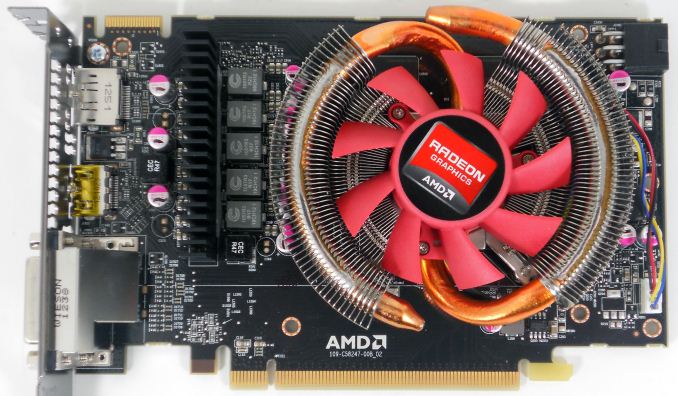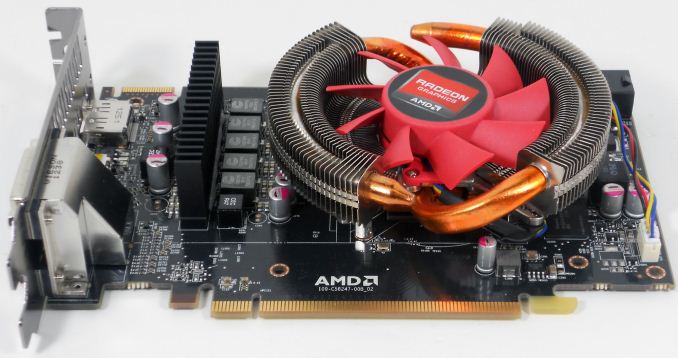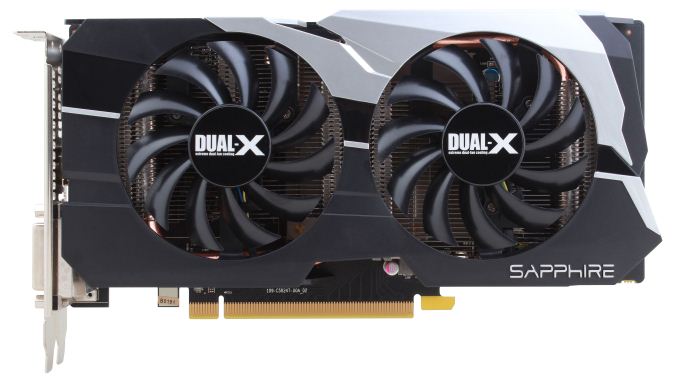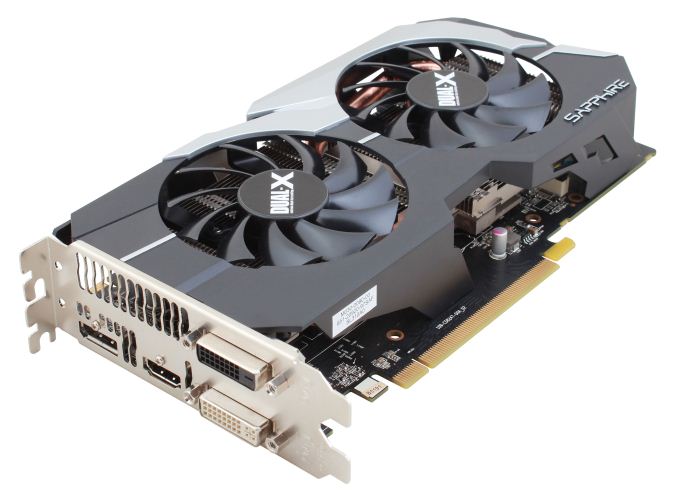AMD Radeon HD 7790 Review Feat. Sapphire: The First Desktop Sea Islands
by Ryan Smith on March 22, 2013 12:01 AM EST- Posted in
- GPUs
- AMD
- Sapphire
- GCN
- Radeon HD 7000
Meet The Radeon HD 7790 & Sapphire HD 7790 Dual-X Turbo
Today we’ll be looking at two cards, AMD’s reference card and Sapphire’s customized HD 7790 Dual-X OC. As is typical for cards in this price segment, the designs are relatively simple and as such only a few partners will be using the reference design as opposed to rolling their own designs. At the same time AMD is pushing their partners’ factory overclocked cards hard – we have the Sapphire and then 3 more on their way – but it’s important to keep in mind that not every last 7790 will be factory overclocked. So AMD’s Spartan reference card is a good example of baseline 7790 performance will be like, including how well it performs with a simple, single-fan open air cooler.
As we alluded to a moment ago, AMD’s reference 7790 is a spartan card. At under 7” long it’s actually shorter than the 7770 and has more in common with the 7750 as far as board length goes. Cooling is provided by a small open air cooler, composed of a circular heatsink with copper heatpipes running up from the base of the card and into the heatsink fins. At the center is a single, small fan responsible for providing the airflow for the card. Meanwhile towards the front of the card we find a small upright heatsink, providing the minimal cooling necessary for the MOSFETs regulating power for the card.
As we’re looking at a 128bit card, memory is provided by 4 6GHz Hynix GDDR5 memory modules, placed on the front of the card underneath the heatsink. A lot of AMD’s partners will be shipping their cards with the memory overclocked to 6.4GHz, which is a fairly common overclock for Hynix’s GDDR5 modules these days.
Elsewhere on the card we can see the sole 6pin PCIe power socket, pointing towards the rear of the card. The 7790 does draw more power than the 7770, and while total power consumption is fairly low, it’s still over 75W and hence requires external power. Meanwhile at the top of the card we can see a single CrossFire connector. AMD believes offering CF here when NVIDIA’s closest product doesn’t (the GTX 650 Ti) is a marketable advantage, but CFing a 1GB card in 2013 strikes us as a poor idea.
Finally, for display connectivity AMD has deviated from the rest of the 7000 series a bit. The 7700 and 7800 series used a single row of display connectors, typically composed of an HDMI port, a DL-DVI-I port, and 2 miniDPs. With 7790 however AMD is dropping the miniDPs in favor of one full-size DisplayPort, and at the same time they’re bringing back the stacked DVI connector.
Taking up space on the 2nd slot of the card’s bracket is a DL-DVI-D port, giving us the first AMD card with two DVI ports in this price range in some time. Note that while Bonaire can drive up to 6 displays it can only drive 2 TMDS-type displays (DVI/HDMI), so the second DVI port can only be used if the HDMI port is not in use.
| Radeon HD 7790 Specification Comparison | ||||
| Radeon HD 7790 (Ref) | Sapphhire HD 7790 OC | |||
| Base Clock | 1000MHz | 1075MHz | ||
| Memory Clock | 6GHz | 6.4GHz | ||
| Frame Buffer | 1GB | 1GB | ||
| Width | Double Slot | Double Slot | ||
| Length | N/A | N/A | ||
| Warranty | N/A | 2 Year | ||
| Price Point | $149 | $159 | ||
Meet The Sapphire HD 7790 Dual-X OC
Moving on, we’re also taking a look at a partner card today, Sapphire’s HD 7790 Dual-X OC. Virtually every partner is releasing a factory overclocked card of some kind with their own take on the design, but Sapphire’s 7790 should be a good representation of what to expect given how similar many of the 7790 designs are.
To that end Sapphire’s Dual-X cooler is your fairly standard twin fan design, utilizing a pair of shallow fans mounted over an aluminum heatsink that runs over the length of the card. A pair of copper heatpipes run from the baseplate over the GPU to the heatsink, with the entire solution serving as an open-air cooler. Note that while Sapphire is using AMD’s reference PC design here, they have lengthened their PCB to match the length of their heatsink, and to allow them to turn the PCIe socket 90 degrees so that it now is against the top of the card rather than the rear.
As given away by the OC name, Sapphire will be shipping their card with a decent factory overclock. Shipping speeds will be 1075MHz for the core and 6.4GHz for the memory, a 7.5% core overclock and 6.5% memory overclock respectively. This will be the most common factory overclock, with several other partners shipping their top-end cards with the same overclock.
Other than the custom cooler and factory overclock, Sapphire’s card is otherwise functionally identical to AMD’s reference card. We’re looking at the same display output configuration of 1x DP, 1x HDMI, and 2x DL-DVI, with the same CrossFire capabilities. Sapphire is putting the MSRP of the card at $159, putting a $10 premium on their cooler and factory overclock.


























107 Comments
View All Comments
Spunjji - Friday, March 22, 2013 - link
...forgive my stupidity. Actual figures of the 7790 here:http://www.techpowerup.com/reviews/Sapphire/HD_779...
Depends on whether we focus on Peak / Max figures to decide whether you or I am closer to the truth. :)
Ryan Smith - Friday, March 22, 2013 - link
Typical Board Power, not Total. TBP is an average rather than a peak like TDP, which is why it's a lower number than TDP.dbcoopernz - Friday, March 22, 2013 - link
Any details on UVD module? Any changes?The Asus Direct Cu-II might make an interesting high power but quiet HTPC card. Any chance of a review?
Ryan Smith - Friday, March 22, 2013 - link
There are no changes that we have been made aware of.haplo602 - Friday, March 22, 2013 - link
somebody please make this a single slot card and I am sold ... otherwise I'll wait for the 8k radeons ...Shut up and drink - Friday, March 22, 2013 - link
Has it occurred to anyone else that this is in all probability an OEM release of the "semi-custom" silicon that will find its way into Sony's Playstation 4 in the fall?Word has it that Sony has some form of GPU switching tech integrated into the PS4.
- apologies for the link to something other than Anand but I don't think they ran anything on the story http://www.tomshardware.com/news/sony-ps4-patent-p...
Initially I presumed this to be some "Optimus"-esque dynamic context switching power saving routine. However, the patent explicitly states, "This architecture lets a user run one or more GPUs in parallel, but only for the purpose of increasing performance, not to reduce power consumption."
Which struck me as some kind of expansion on the nebulous "hybrid crossfire" tech that AMD has been playing w/since they birthed the 3000 series 780G igpu
Based off of AMD's previous endeavors in this area on the PC side I would be skeptical of the benefits/merit of pairing the comparatively anemic iGPU's of Kabini w/a presumably Bonaire derived GPU.
As an aside; since SLI/CFX work by issuing frames to the next GPU available, if one GPU is substantially faster than the other(s), frames get finished out-of-order and the IGP/slower-GPU's tardy frames simply get dropped which may make the final rendered video stuttery/choppy.
Pairing an IGP with a disproportionately powerful discrete GPU simply does not work for realtime rendering.
It is certainly possible that with the static nature of the console and perhaps especially the unified nature of the GDDR5 memory pool/bank that performance gains could be had
However, my digression on the merits of the tech thus far is
128 + 128 = 256 + 896 = Anand's own deduction of 1152sp's)
Shut up and drink - Friday, March 22, 2013 - link
I pushed submit by mistake...damn...oh well...my last point of arithmetic was simply that 1 fully enabled 4 core Kabini's I'm suspecting would have a 128 shader count igpu. Factor in the much ballyhooed 8-core Cpu in the PS4 we would have two Kabini's (128+128=256) + a Bonaire derived 896sp GPU all on some kind of custom MCM style packaging "semi-custom APU" (rumor had it that the majority of Sony's R&D contributions were in the stacking/packaging dept.)
Anyone concur?
Shut up and drink - Friday, March 22, 2013 - link
...which jives w/Anand's own piece that ran on the console's unveiling, "Sony claims the GPU features 18 compute units, which if this is GCN based we'd be looking at 1152 SPs and 72 texture units"http://www.anandtech.com/show/6770/sony-announces-...
A5 - Friday, March 22, 2013 - link
Yeah, once this came in at 14 CUs with minor architecture changes, it seemed like a likely scenario to me.Obviously it isn't going to give you PS4 performance on ports with only 1GB of memory, though.
crimson117 - Friday, March 22, 2013 - link
Good thought, but I sure hope Sony doesn't hamstring its PS4 with a 128-bit memory bus!